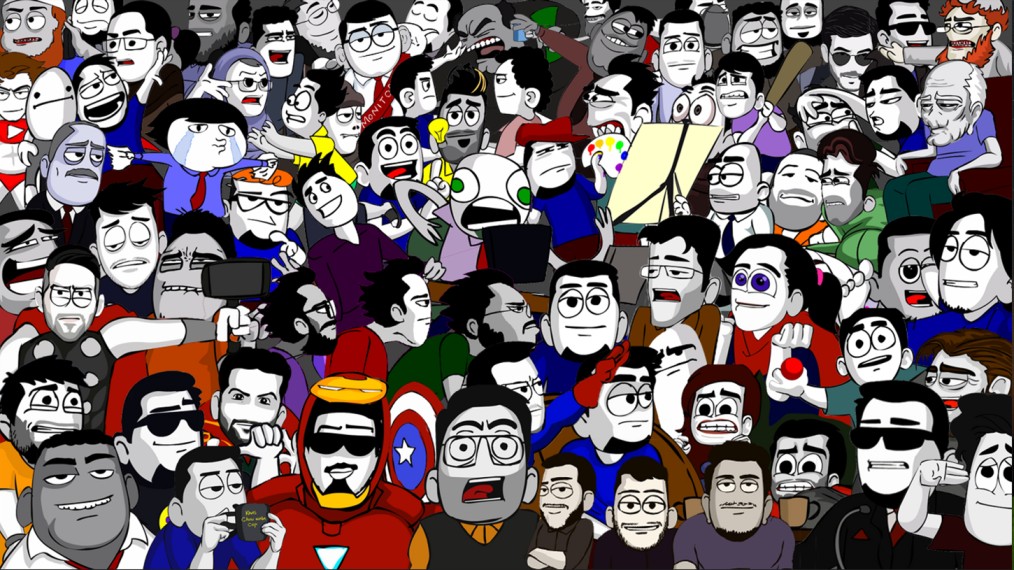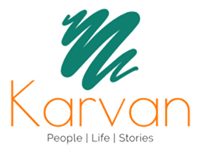Since its debut on YouTube, Sharum Ki Sketchbook has captivated our attention with its diverse storylines and a plethora of unique yet relatable characters. From Dilbar and Dabeer to the unforgettable Khalida Aunty and the irritating neighbors, Sharum’s artistic ingenuity has enthralled us by vividly portraying the intricacies and humor of life. We are delighted to present his exclusive interview for Karvan.org, offering a deeper insight into the creative genius behind the sketches that have left a lasting impression on us all.

1. Can you provide a brief overview of your background and how you got started in graphic design and digital storytelling?
Well, my name is Sharum. (It’s a Persian name that translates to “the city of happiness”). I was born in Quetta. My parents and relatives are from Quetta as well. I spent the first 18 years of my life in Karachi where I received my schooling. I later moved to Islamabad and graduated as an Aerospace Engineer. After graduation, I worked for three years in the engineering field, cleared my Aircraft Maintenance Engineering certification papers, and addressed lectures on various aeronautics subjects as an instructor at my university and to the Pakistan Air Force officers at PAF Kamra Base.
Well, wait a second… you might be wondering if I am the right person. This past account doesn’t add up to me being the guy behind Pakistan’s first animated show, “Sharum ki Sketchbook”.
So, here’s the missing information. I have been drawing ever since I can remember. Maybe, I was introduced to this art by my father. My elder brother also used to draw a lot as a kid. There was this sketch of my dada (paternal grandfather) – made by his friend, the famous artist, Sadeqain – framed on our wall. It inspired me a lot to draw as a kid. I had an art teacher at primary school, Ms. Naila Niazi. She played an immense role in motivating and inspiring me as an artist. As a kid studying in the third grade, I used to compete and win art competitions among eighth graders. Since I watched cartoons a lot, it inspired me to create characters and stories of my own. I made my first flip book with hand-drawn animation in 2004. I read superhero comics as well.
All this sums up to me getting started as an artist in my childhood. I was blown away by the endless artistic possibilities when I was introduced to the computer in 2005. This was the beginning of my upcoming digital art experiences. I used to spend hours messing around with Microsoft Paint, Adobe Photoshop, Adobe Flash, stop motion animation, video editing, etc. This was in 2007 when I had ample time ahead to learn. Little did I know! Time passed and studies took a toll on my inner artist. Though I did manage to create my first animation channel in 2010, it soon became a withdrawn matter as I got busy with academics. Fast forward, I got admission and left Karachi for Aerospace Engineering. At the university, I was studying “Rocket science”. The studies and hectic grading system left me with no time for myself and my hobbies. Art became a distant memory. Post-graduation, the job market was a rat race. The only art I could manage to create was those doodles and scribbles I mindlessly made on the last pages of my notebooks during classes and at my job. I was professionally progressing but my passion for life was gradually receding. In a matter of time, I found myself in a dark place. Maybe I was burnt out of pursuing a path that meant nothing to me. Cut short, there came a time when I had to make a decision. I had to take a brave step. So I decided to give art a professional shot. I pondered. The dots connected. I could see that I had been a good observer, I loved stories and could draw well. So I gathered my talents and came up with an idea — the idea of telling stories via hand-drawn animation.
2. What is your typical creative process when conceptualizing and designing a digital episode for Sharum ki Sketchbook?
I observe. I observe all the time. I reflect a lot. I find people and life very interesting. I tend to observe the nuances of life that people often ignore. I take notes from my surroundings. I have been doing this all my life. But now I observe with an organized and managed approach. This is why I tend to stay anonymous: I can observe people without them recognizing me in public. I have a diary that is full of my wildest ideas. Most of them might not make it to the public but they are there, safe and handy. I don’t follow the YouTube trends. I follow my instinct. I have a list of topics I want to touch on. When a topic comes to my mind for execution, I gather all my observations, let my mind wander, and jot down whatever I imagine. Once I am done with the brainstorming session, I craft my script, give it a flow, and formulate an episode after multiple omissions and additions. Once the final draft is ready, I move ahead with the storyboarding, recording, sound design, animation, and post-edit.
3. Where do you draw inspiration for your stories and characters?
Anything and everything. I observe all the time. People around me, how they talk and behave, cars, buses, children, plants, etc. There is no limit. One thing about inspiration is that it comes naturally. You just have to be available at the receiving end. Observing. Inspiration and ideas pop up at the most unexpected times. You have to be ready to note them down.
4. What role do you believe graphic design plays in conveying cultural and societal messages?
Massive! I can’t emphasize more. What a character wears, how it stands, what colors the designer uses in the graphics, the typography, etc. It all contributes to telling a story. Two characters with the same expressions but different hand gestures can convey completely different emotions. I am just a student in this vast field and the dimensions are endless. With a strong graphic designing skill, you can tell a good story. A good story is all you need to successfully convey an idea or a message.
5. What challenges do you face in visually communicating complex ideas?
It’s not easy running an animated show on YouTube. All the frames in my animations are hand-drawn. This takes time. If I put in too much time, the delay harms the channel’s reach. I try my best to find a balance. This is the reason my audience often complains that I upload videos too late. I often discard many ideas and scenes because if I try animating them, it’ll take me an eternity.
6. Can you share the key digital tools and software you use in your design process, and how they contribute to the final outcome of your episodes?
I mostly use Adobe Animate, Adobe Premier, and Adobe Photoshop for the graphics. For sound engineering, I use NCH Wavepad.
7. How did you create characters like Dilbar, Dabeer, Khalida, Tufail Sahab, and others? Did you draw inspiration from real people?
I used to create imaginary characters as a kid. I also used to mimic people a lot. I think I created and evolved the character of Haji Dilbar with inspiration from multiple people including my college professor, a butcher I remember from Karachi, a fellow passenger from some flight, etc. It’s not all too straightforward. Most of these characters are more of an evolution. I just get that feeling. It feels like I know these characters from real life and I just have that instinct on how a character would act in a specific scenario.
8. What impact do you hope your digital episodes have on viewers?
I believe change can never be forced. To incept an idea among the audience, to inspire someone, you need to get in their shoes. You need to first live their lives. In addition, you need to add value. For instance, if I just preach straight forward, “spend time with your family”, it won’t have an impact. But if they make a video the whole family can relate to, they might watch it together. Mission accomplished!
Or if I tell people, “Hey! You should be a responsible citizen who shouldn’t litter”. It won’t have an impact. But if I show an irresponsible character as a mere idiot, making fun of it as to how it throws garbage with zero brain cells, in a way that the sketch makes people laugh and ponder at the same time. They will remember the character the next time they are in a similar situation. Mission accomplished! This is what I call “positive culture hacking”
9. What is your message for those aspiring to become graphic designers and visual storytellers?
Whatever you want to become, aim at being the best. For that, you’ll need to put in hours, nights, days. You’ll need to be obsessed. All great things take time. Time is passing anyway. Why not use it? Remember that there is no room for mediocrity if you want to succeed. So outwork all your self-doubts. Work so hard that there comes a time when others can’t ignore your achievements. What better way is there to live?
10. Your message for the youth of Pakistan?
Your life matters! You have talent, ideas, skills, and potential. The world needs that. With the internet, you have everything you need to achieve your dreams. Stop being lazy and afraid. Say no to mediocrity. Winners always find a way to win while losers always find an excuse. Find a way! Find a way to be better every day. Start working on that dream you have. You deserve that. Lift yourself. Work your way to the day when you can proudly say that despite all your hardships, you made it there. Inspire the world!
Here are the authentic links for Sharum Ki Sketchbook:
https://www.youtube.com/@SharumKiSketchbook
https://www.instagram.com/sharumkisketchbook
https://www.facebook.com/sharumkisketchbook
https://www.patreon.com/sharumkisketchbook
KARVAN envisions showcasing the best and the brightest talent from Pakistan. If you have achieved an academic, personal, or professional milestone, or know someone who did, do send us a brief profile at [email protected].
Find us on Facebook: @talktokarvan
